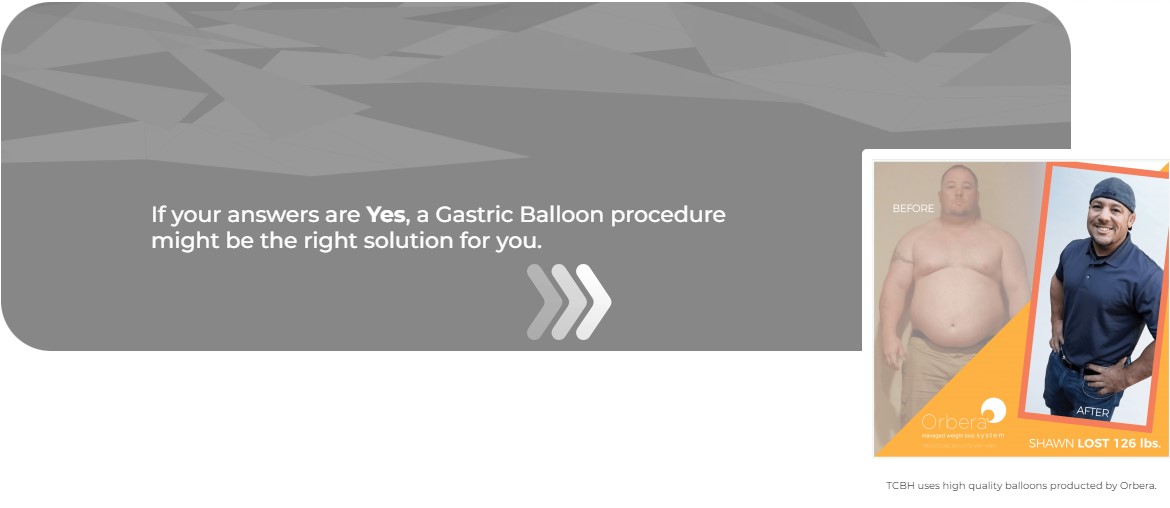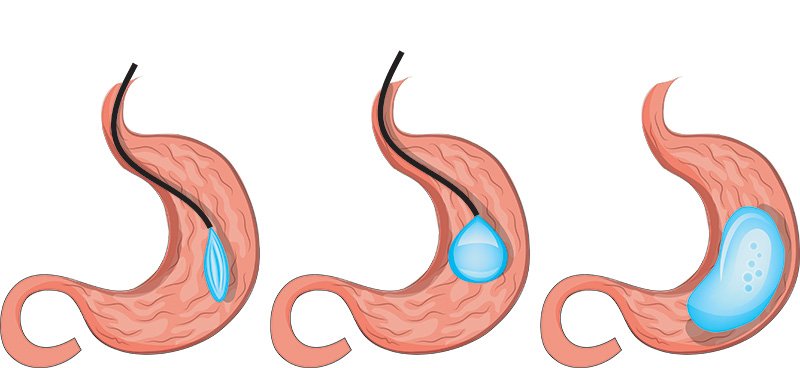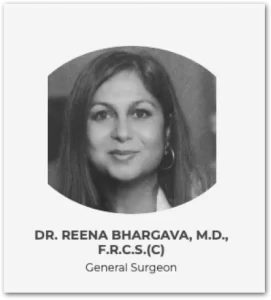Call: (647) 352–3233 | Fax: (416) 630–6415
Orbera Gastric Balloon
Call Us at 647-352-3233
Are you looking for a healthy and long-term solution to lose stubborn weight?
Do you have a busy lifestyle that does not allow you enough time for exercise?
Are you concerned about risks and recovery time associated with weight loss surgeries?
Is your BMI between 30 and 40? (How to calculate BMI)

What Is A Gastric Balloon?
Intragastric balloon (IGB) is a treatment for obesity and has been developed so you can lose considerable weight in about 6 months. IGB placement is established as a safe, relatively low-cost, and well-tolerated minimally invasive procedure for weight loss, giving encouraging results with the strict prerequisite that the patient will enroll in a medically supervised weight loss program. The gastric balloon is entirely reversible, and it doesn’t change the anatomy of the stomach, making it a very safe procedure.
During the procedure, a soft silicone balloon is delivered into the stomach with the help of a camera called an endoscope, making the procedure incision-less. Once the balloon is safely placed in the stomach, it is filled with saline (saltwater). As the filled balloon is too big to move onto other parts of the digestive system, it floats in the stomach freely.
As a result of the procedure, the balloon gives the patient a sense of a half-full stomach, which prevents overeating and reduces the amount of food the patient can or wants to eat. That’s why it’s essential to stick to a healthy diet and regular exercise to get the maximum results.

Who Is Suitable for a Gastric Balloon?
- Your body mass index (BMI) is between 30 and 40.
- You do not want the risk of complication associated with surgical weight loss procedures.
- You’re willing to commit to healthy lifestyle changes, get regular medical follow-up and participate in behavioral therapy.
- You have not had any previous stomach or esophageal surgery. If you do not meet the criteria for bariatric surgery, intragastric balloons may be used to achieve weight reduction.
How does a Gastric Balloon compare to a surgical weight loss procedure?
While many surgical procedures for weight loss such as liposuction and tummy tuck can deliver good results very quickly, a gastric balloon has certain advantages that might be beneficial, including:
- No general anesthetic used.
- No cutting, no open wound, no scars.
- Very low risk of complication associated with surgeries.
- Quick but sustainable results in losing weight.
- Minimum downtime after the procedure because there is no surgery involved. Patients usually leave the clinic in a few hours post procedure.
- Requires minimum change of lifestyle. No starving or tons of exercises required.
Personalized Nutrition Plan
At TCBH, we utilize a method called Metabolic Balance® to achieve greater results. Metabolic Balance® is an innovative all-natural nutrition program that balances hormones and optimizes health: the result is successful long-term weight management. NO hunger, NO cravings, NO injections/pills/shakes, NO keeping “points” or counting calories.
We develop an individualized nutrition plan for you. The Metabolic Balance® method has achieved success with those who suffer from PCOS, Type 2 Diabetes, Rheumatism, Migraines, Insulin Resistance., High Blood Pressure, Fatigue, High Cholesterol, Imbalanced Cholesterol, Osteoporosis, Allergies and Skin Disorders.
Why Choose TCBH
The Clinic at Beverly Hills is a brand new 8200 square foot, state-of-the-art, multidisciplinary healthcare facility located in Toronto. We have created a comprehensive Gastric Balloon Program to increase the amount of weight you should lose and ensure that you are able to keep it off.
- Full assessment of suitability
- Access to our nutritionist and wellness coaches for 1 year
- Gastric balloon procedure
- Follow up with your surgical team
- Metabolic Balance® program


Meet Your Surgeons
Dr. Reena Bhargava
- General Surgeon specialising in Endoscopy and General Surgery
- Registered with College of Physicians and Surgeons of Ontario
- University of Western Ontario (Medical School and Surgical Residency)
- Minimally Invasive Fellowship at the University of Cincinnati Ohio
Gastric Balloon Consult
FAQ
How to calculate BMI?
Body Mass Index is a simple calculation using a person’s height and weight. The formula is BMI = kg/m2 where kg is a person’s weight in kilograms and m2 is their height in metres squared. A BMI of 25.0 or more is overweight, while the healthy range is 18.5 to 24.9. BMI applies to most adults 18-65 years.
Why Choose TCBH for Your Weightloss Goal?
This plan acts as a “road-map” that gives you the exact natural foods needed to orchestrate biochemical changes for individualized weight and health goals such as cholesterol, blood pressure and diabetes.
The program offers you a personalized nutrition plan based on an in-depth analysis of 37 different blood lab values and your medical history. Your personalized plan will indicate exactly which natural foods and the quantity you should eat them, in order to balance your personal “body chemistry” with the right “food chemistry”.
If weight loss is your goal, you can experience rapid weight reduction. Metabolic balance® is 100% natural! NO hunger, NO cravings, NO injections/pills/shakes, NO keeping “points” or counting calories.. You aren’t alone on the Metabolic Balance® program. Throughout the four phases (preparation, strict conversion, relaxed conversion, and maintenance) of your program you are supported by your Metabolic Balance® coach.
With the Balloon and the Metabolic Balance® approach let us help you lose weight.
What Can You Eat After Gastric Balloon Treatment?
As typically with gastric operations, the first few days and weeks of diet after the gastric balloon procedure is solely based on liquids, purees, and other soft foods. The transition from liquids to more solid food goes slowly step-by-step as it is necessary to get your body comfortable with the balloon and avoid nausea. After the initial liquid diet, you can move on to normal textured solid foods after around two weeks. It is vital to follow the diet recommendations and start eating healthy and exercising more.
Risks for Gastric Balloon Procedure
Even though the gastric balloon procedure is non-surgical and straightforward, there are still some risks to be aware of:
- Dehydration – because of the balloon, there might be difficulty in consuming an adequate amount of liquids. However, this problem usually goes away after the stomach has adapted to the balloon.
- Severe nausea, stomach cramps, and vomiting – usually normal and expected during the first few days. Not to worry – you will be given medication to help prevent and alleviate it.
- Ulcers – mostly caused by the balloon irritating the lining of the stomach. To reduce the risk, it’s essential to avoid taking nonsteroidal anti-inflammatory drugs (NSAIDs) such as ibuprofen or naproxen. Doctors typically give patients omeprazole or other proton pump inhibitors to reduce stomach acid while the balloon is in place.
- Balloon deflation – occurrence is low. However, it can be a hazardous situation where the silicone balloon is compromised, deflates, and could move through the digestive system where it might cause a blockage. Deflated balloons must be removed endoscopically.
- Early removal – due to intolerance. Not very common, but patients are given medications to help them through their nausea if it happens.
- Gastric perforation – also very rare, but the higher risk is for the patients who have a prior history of stomach surgery.
Who is NOT Suitable for A Gastric Balloon (Contraindications)
Even if your physical condition (i.e. BMI) is suitable for the gastric balloon procedure, some contraindications might not give you the “green light” for that procedure:
- currently pregnant or breastfeeding
- serious liver damage (e.g. cirrhosis)
- history or current use of blood-thinning medications
- prior history of stomach or bariatric surgery (e.g., gastric bypass, nissen fundoplication, gastric surgery, or sleeve gastrectomy)
- anomalies in the gastrointestinal tract (e.g., large hiatal hernias that is greater than 5 cm, acute inflammation in the esophagus or presence of stomach ulcers)
All in all, the gastric balloon procedure is an option for weight loss, especially if you haven’t succeeded with diet and exercise before. This safe, non-surgical, and simple procedure can give you the kickstart to get you on the path to a healthier life!